PAGE 80a – December 2008
H O T I D E A S F O R S M A L L R A I L R O A D S

In This Issue
Winter Scenes:
‘Glittter Houses’
XTS Toy Trains and Tracks
Trams of a Winter’s Night
The Last Word from Winter
‘World’s Smallest’ Challenge:
Top Two Prize Winners
Distinguished Runners Up
Two Citations of Excellence
What’s on our hobby minds this year at this time? Two things, at least! One is: who are the winners of the World’s Smallest Working Model Railroad Challenge? No more suspense, the winners (and other inspiring entries) are right down the page.
The other thing on many of our minds is: seasonal model railroads. This time of year it’s fun to put together a small display layout for a showcase location in the house. The season for scenery (in the northern hemisphere)? Winter, of course! Here are some examples.

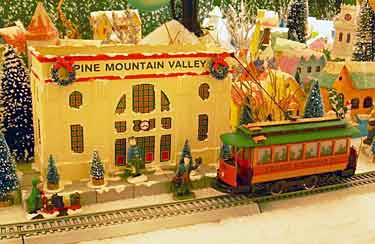
Howard Leroy Lamey, from Jacksonville, Florida USA, makes and collects cardboard “glitter houses” (in a style popular from the 1930s to the 1950s) as his main hobby. Each year at this season he sets up a display including a railroad—and this year it’s under his Christmas tree and features a Bachmann bump-and-run trolley/tram! Here are some photos of his delightful show… our thanks to Howard for permission to use his photos here and in the page title above. For more about Howard’s efforts, see his website.
Dan MacKellar, who lives in Canada, sent photos of a clever 18x6in (45x15cm) N-gauge layout made from an XTS Train System toy set. Dan commented, “The layout was populated with people from a package of small ornaments. I scratchbuilt the house and station. The snow was painted on with a grit paint compound and painted white.”
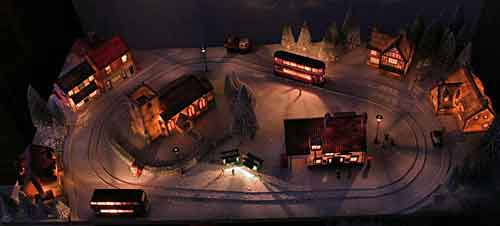
Markus Hartwig, from Pulheim-Brauweiler (near Köln/Cologne), Germany, built this charming British style H0 tram (trolley) layout as a Christmas decoration for his living room. Baseboard size is just 100x50cm (39.4×19.7in). Markus also revealed a little secret: “Serious modellers may kill me, but after awhile I switched off the motor, and the tram became a static display as I could not stand the noise for hours.” I understand exactly how he feels!
CHALLENGE WINNERS!
The World’s Smallest Working Model Railroad Challenge was launched in mid-September 2008. The competition was designed to “find and present to the public the smallest and most elegant possible model railroad layout. The Challenge rules insure that it will be a recognizable, working layout that the general public will understand as an achievement.”
The challenge closed at the end of November, and the judges have been scrutinizing the entries to discover the winners. There are two (very small) prizes: one for the smallest volume (length times width times height) of a layout; the other for the smallest ratio of the layout’s length relative to its track gauge (to allow large-scale entries an opportunity to win). The winners in each category are presented here—congratulations to them both!
During the process the judges also found some ingenious, creative, and inspiring accomplishments among the entries, and so authorized a category of “Distinguished Runners Up.” These are also presented below. So sit back and enjoy a tour of some of the smallest and cleverest model railroad layouts to be found in the world today!
Illnau, Switzerland

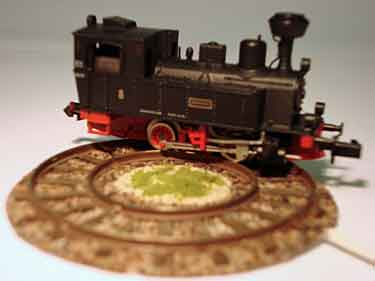
The smallest volume entered turned out to be 11.31 cubic centimeters, or 0.69 cubic inches — about 2/3 of a cubic inch! Felix selected N scale because he felt it was the most reliable performer in the small scale sizes. And he figured that a simple circle of track would be the most space-efficient design. He used a CAD program to set the smallest radius possible for his N locos, which turned out to be 20.5mm, yielding a layout diameter of 6cm. Because he needed to relax the gauge by 0.5mm to accommodate the very small radius, he handlaid the track—his first attempt at that task! By using a very thin base, he held the thickness down to just 4mm.
To see his prize-winning result, watch Felix Geering’s video at right.
LAYOUT WITH THE SMALLEST LENGTH-TO-GAUGE RATIO, REGARDLESS OF SCALE:
Christophe Marsault
Montgeroult, France
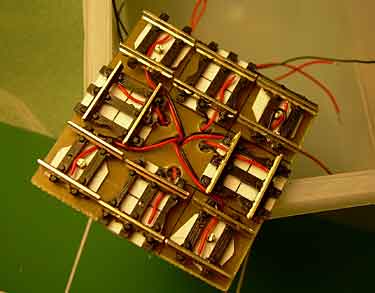
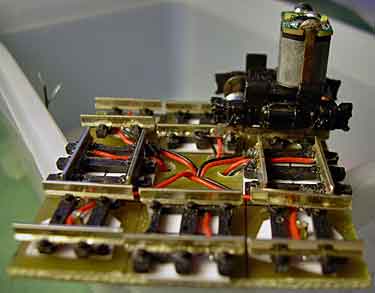
Christophe’s entry falls into the “darndest thing I ever saw” category. Using higher mathematics, he determined that this square format was the most space-efficient possible design for a loop of track! The layout side needs to be three times the loco wheelbase. In this case, that led to a 45mm (1.77in) square of N track. The four corners are all pivoted. “For operating the system,” explains Christophe, “you progress to one dead end, stop the machine, turn the sector, and run to the next corner. And so on… I plan to turn corners with a small T or L shaped tool.”
The thickness of the layout as built measures 5.69mm, yielding a total volume of 11.52 cubic centimeters or 0.70 cubic inches — only 0.01 cubic inch larger than Felix’s winning entry! However, because of his super-efficient layout geometry, Christophe’s length-to-gauge ratio was just 45mm:9mm, or 5:1… easily winning the ratio award!
Although I think it would be difficult to find a prototype for this particular track arrangement, Christophe’s ingenious entry richly deserves our congratulations! He exhibited the little layout (and the O scale speeder he’s constructing to run on it) at RailExpo 2008 in Paris at the end of November. It’s shown in photos 20-24 on this page.
AND HERE ARE THE DISTINGUISHED RUNNERS-UP
Nearly all the entries in this Challenge showed considerable inventiveness and craftsmanship… so much so that the judges felt they should be presented as Distinguished Runnners Up, to provide inspiration and ideas for other space-starved modelers. After seeing this gallery, no one will ever again feel that he has no space for a model railroad layout!
Here, in no particular order, are the Distinguished Runners Up in the World’s Smallest Working Model Railroad Challenge. I think you’ll enjoy them!
Push the Wagon, Pull the Wagon
Tim Halket, England
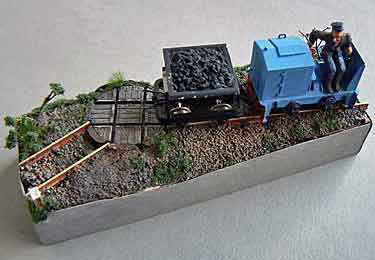
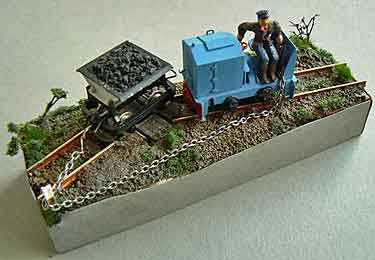
Push-the-Wagon-Pull-the-Wagon is a OO9 layout (4mm scale, 9mm gauge) that measures 4×1¼in (10.2×3.2cm). It features Peco Crazy Track and Wagon Turntable, plus a vertical rail to throw the shunter’s chain around. The objective is to move the car from one spur to the other. Tim provided a very clear guide to operation:
To part the wagon from the loco:
Wagon begins in position coupled to the loco (above left).
Wagon then gets pushed onto the turntable and uncoupled.
The turntable is rotated (use your finger!)
A chain is attached to the end of the wagon farthest from the loco, looped around the upright rail and attached to the loco (above right).
The loco reverses, pulling the wagon away from it (in the opposite direction) and off the turntable onto the opposite spur.
To reverse the procedure:
Drive the loco up to the turntable.
Attach the chain to the closest end of the wagon (below left).
Reverse the loco pulling the wagon onto the turntable (below right).
Remove the chain and rotate the turntable.
Drive the loco back up to the turntable and couple-up.
Reverse the loco with the wagon coupled to it.
Tim comments, “Quite a bit of faffing around – but great fun! A very delicate hand is required.” He was inspired to make a chain-shunting layout by seeing Colin French’s The Wagon Works layout at an exhibition. You can see it in Scrapbook #54.
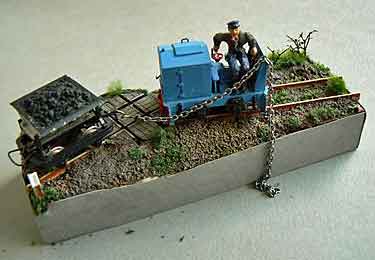
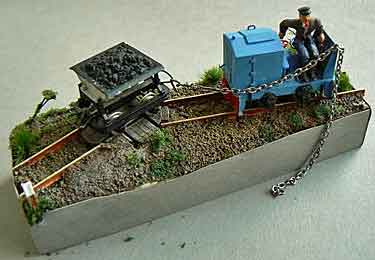
Z Scale is SMALL!
Carsten Weye Jensen, Denmark
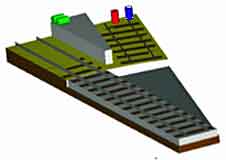
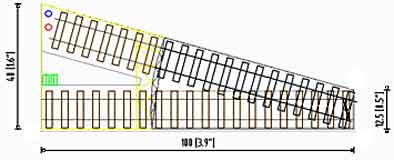
Carsten is a zealous Z-scale fan, and he has contributed a number of excellent Z layouts to this site over the years. His Challenge entry is — what else? — a very tiny Z-scale layout. It essentially consists of a 65mm (2½in) sector plate and two 35mm (1-3/8in) spur tracks flanking a loading/unloading dock. Rolling stock would be a Köf II switching loco and a small 33mm long car. Note that, in this case, using a sector plate is more space-saving than a transfer table, because it requires only a triangular plot rather than a rectangular one!
Dampfer
Chris Bayley, North Wales
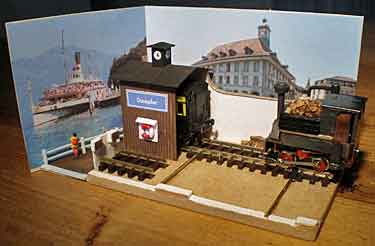
Chris’s entry is an N scale layout that “represents the small annex of a busy European station, its purpose being to convey passengers to the lakeside and lake steamers. Hence it came to be called Dampfer (steamer) to distinguish it from its more illustrious neighbour. The length of the layout is 3½in (89mm) and width is 2in (51mm).” The steam locomotive is scratchbuilt. Chris comments, “It all works very well indeed, and I find operation very relaxing as I don’t have to make decisions, except when to water the engine!” Note that a small backdrop and tiny bit of esplanade have been added to the layout for photographic purposes, showing how much a little scenery can improve the appearance of our work.
MiNiverser
John Garaty, Australia


John’s entry comes under the heading of “diabolically ingenious, though not at all prototypical!” The entire N-scale layout is a traverser leading into a gauntleted track, thus feeding two interwoven sidings (a great space saver)! Dimensions: 118.2mm (4.6in) long and 26.54mm (1.04in) wide. Total lateral travel of the traverser is 2.5mm! Rolling stock is a Minitrix British Railways side-tank loco and Graham Farish Esso oil tanker, both well over 10 years old.
John also offered some tips for further reducing layout size: use a short railmotor (self-propelled passenger/goods unit) rather than a loco and goods wagon; use .020in thick styrene instead of .040in for a baseboard; shave the thickness of the sleepers (crossties); use a smaller code rail.
Westcott Inlet
John Lucas, United States
John writes, “Westcott Inlet is a linear N-scale layout built on a 12-inch ruler (the name Westcott came from the ruler). The layout represents a branch line that crosses a small inlet on a swing bridge. The idea is that a short train with a locomotive pulling one car pulls onto the bridge. The bridge is then swung 180 degrees, putting the train into position to drop off the car on the other end. The locomotive can then return across the bridge until it is time to pick up the car. Admittedly, it is not very prototypical to turn the bridge with the train on it, but I found it to be a reasonable compromise.”
The layout measures 12x1in (305x25mm). John drew some of his inspiration from the Z-scale Einfuss layout in Scrapbook 71a. The photos below illustrate the process of moving a car from one side to the other.
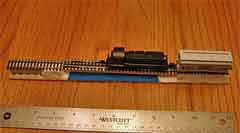
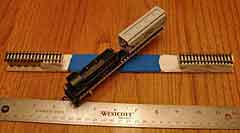
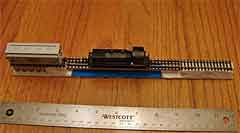
Pizza on a DVD
Murray McKenzie, New Zealand
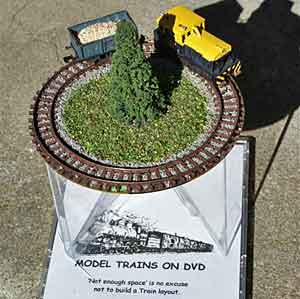
Murray’s pleasant N-scale layout circles a 120mm (4.7in) DVD. He claims, “This is probably New Zealand’s smallest working Layout. A 4.5 Volt battery keeps it happily running for hours.
“It’s a Bachmann N Gauge 0-6-0 Diesel Shunter coupled to a Lima wagon with fine chain. The challenge of running an 0-6-0 on a track this small was met by carefully removing the flange from the middle wheelset as the flange ran on the outside of the inside rail. This was done on a full sized lathe which looked, as you can imagine, rather ridiculous!”
The Man Who Made the Most Entries (3)
Thomas Carpenter, England
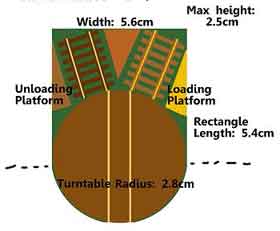
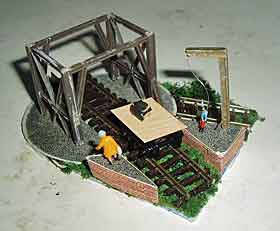
Thomas set a record for “most entries by a single individual.” He submitted three. One was purposely built for this challenge and is shown in the upper photos (right and left). This is an N-scale layout based around a small turntable and two goods (freight) platforms. Thomas named it with an atrocious pun: Two Platforms on One ‘N’-d. The rolling stock consists of one Micro-Trains truck converted into a flat and a tiny diesel loco found on eBay. Dimensions are listed on the track plan.
The other two layouts are ones we’ve seen before, in Scrapbook #60a. A Z-scale pizza based on a miniDVD (8cm (3.1in) in diameter) (lower left photo) and an HO pizza on a CD, 120mm (4.7in) in diameter. For more on Thomas’s work in this area of very small layouts, see his website.
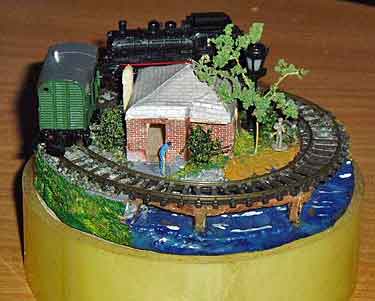
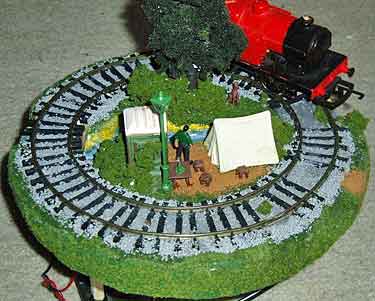
Trundle Quarry Light Railway
Bill Brignell, England
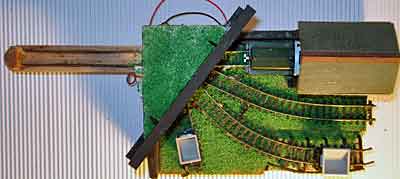
Bill, who has been modeling for 40 years, built his very first micro layout in order to enter this challenge! It’s called the Trundle Quarry Light Railway and is built in OO9 scale (4mm scale on 9mm gauge). The baseboard measures 150x100mm (5.9×3.9in). There are no turnouts and route selection is by means of a sector plate made from a large Popsicle stick! Bill comments, “The layout is fully working, and I can spend as long as I like switching (shunting) back and forth with 5 wagons and a 30 year old Roco Diesal locomotive.”
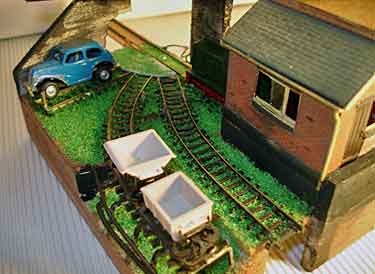
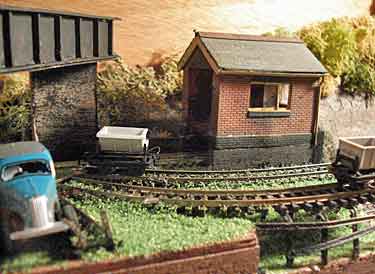
TWO SPECIAL CITATIONS OF EXCELLENCE
A number of layouts submitted were rejected by the judges as non-conforming to the rules of this competition. However, two of these entries had such merit that the judges recommend they be published as inspirations for other modelers of very small railways. We’re proud to present two new micro layouts with Citations of Excellence.
Bayed Guano Grit
Kevin Olsen, United States
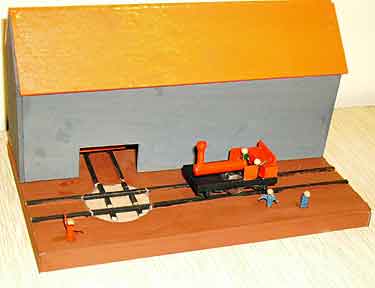
Kevin’s layout named Bayed Guano Grit (an anagram of “Tiny Broad Gauge”) uses N gauge wheels and track to represent a British 7-foot broad gauge prototype. This gives the layout a scale of approximately 1:240. A major cargo hauled by this particular railway was guano from South America, in wide use as commercial fertilizer.
Kevin comments, “Bayed Guano Grit has a single siding to the Guano Works with a turntable leading into it. This track arrangement was common in the early to mid 1800s when rolling stock was still relatively small. The locomotive is a freelanced model based on a broad gauge tank engine circa 1860… The locomotive is unpowered but is built using steel parts (the boiler and tank) so that it can be moved by a magnet under the layout. The rails are basswood strips. Because no commercial figurines are available in this scale the figures in the photographs are fashioned from a bit of basswood, fine wire for arms, and a bead for the head. The entire model is built to a footprint of 3x5in (7.6×12.7cm).”
Kevin is a dedicated modeler of very early railways.
Linkstadt-Rechtsdorf
Nigel Beeton, England
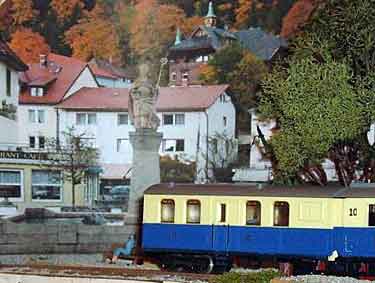
From lively Linkstadt…
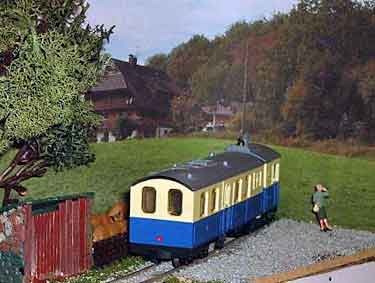
… to rural Rechtsdorf
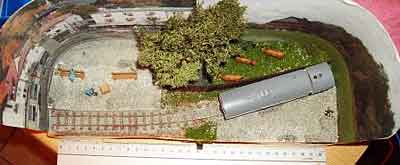
Nigel claims his little H0e layout is possibly “the smallest passenger layout that actually goes from somewhere to somewhere else… The railway runs from the sprawling metropolis of Linkstadt at the left hand end of the layout to the sleepy Black Forest village of Rechtsdorf, where the cows outnumber the people by exactly 3:1.”
Layout dimensions are 310x110mm (12.2×4.3in). Rolling stock comprises a single Egger-Bahn railcar. Nigel’s strategy is very similar to Chris Gilbert’s in his Stourbridge Town (a six-foot G scale layout at the opposite end of the size spectrum): he shows both ends but leaves out the long, boring middle part. A special commendation is due Nigel for his splendid scenic treatment of this theme!
AND NOW, A FINAL WORD FROM WINTER!
To briefly revisit our original theme — Winter holidays — and to remind us all
of the important notion that Model Railroading is Great Fun… here’s a last word
from G. Geoffroy, from Neuves-Maisons, France, the clown prince of European modelers.
He actually posted this on YouTube! Click on the triangle to begin.
Happy Holidays and a Joyous Railroading New Year to All!
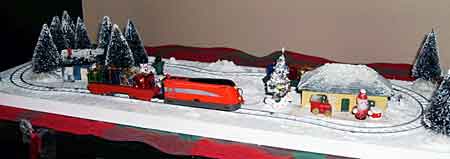
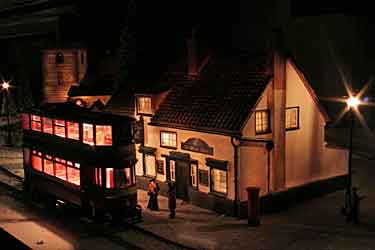
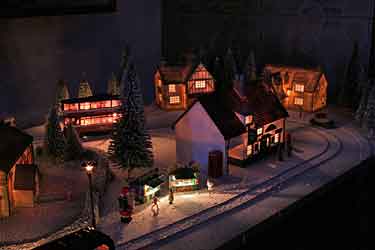
Leave a Reply